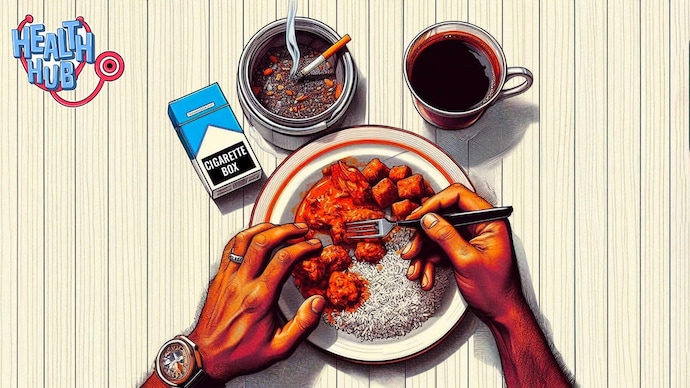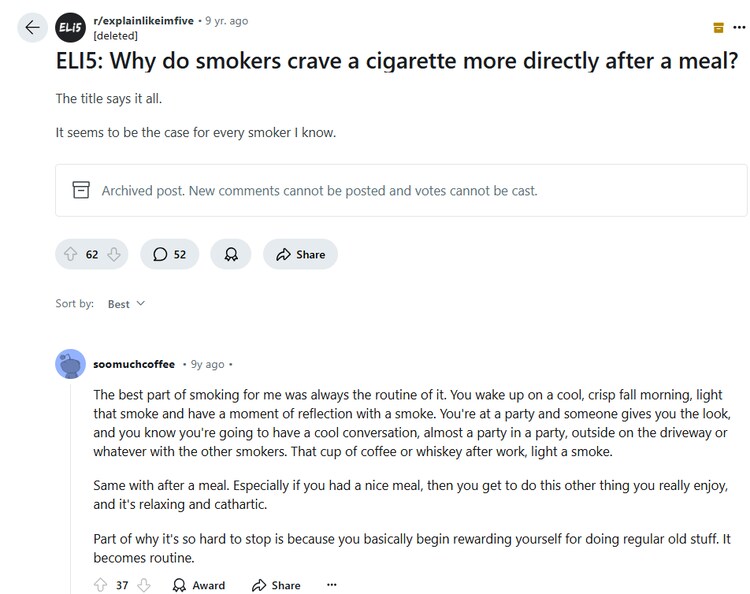Why do smokers feel the urge to smoke after every meal?
The urge to smoke after a meal is a complex interplay of biological, psychological, and social factors, which often provides temporary satisfaction but with serious long-term health consequences.

“There’s nothing like a smoke after a meal” – says Verne Tessio in the 1986 American film Stand by Me. This is what many smokers are going for when they finish – the rush of relief, the dopamine effect.
Smoking has huge effects on the body – the heart, the lungs, and even the neurotransmitters in the brain. There are decades of studies and evidence on the negative effects of smoking and how the desire to smoke after a meal has become ingrained in their daily routine.
Experts suggest that a combination of biological, psychological, and social factors fuel this craving, making it more than just a bad habit.
Here we explore the science behind this phenomenon and its effects on health.
desire to smoke
According to the UK National Health Services, cigarette smoking interferes with certain chemicals in the brain. When smokers don’t want to smoke, it makes them irritable and anxious.

While cigarettes are made of many substances, nicotine is the main ingredient drug in tobacco that triggers the release of chemicals in the brain. Over time, as you smoke more, it begins to stimulate different parts of the brain. Gradually, your brain becomes addicted to nicotine.
According to the US Centers for Disease Control and Prevention (CDC), nicotine alters how your brain functions. Gradually, smokers feel fine when they smoke and become upset or irritable when they do not smoke.
desire to smoke after meals
The desire to smoke after a meal is not just a random craving, but a complex interplay of biology, psychology, and habit. Although the ritual may provide temporary satisfaction, it has serious long-term health consequences.
The reason people smoke after meals is that they get into the habit of smoking in their regular routine. When you quit, it may be difficult for you to perform these routines without a cigarette in hand.
A study published in the peer-reviewed journal Addictive Behaviors looked at how different types of food affect cigarette craving and satisfaction. Twelve heavy smokers were tested over three evenings.
Each day, they smoked three cigarettes and were given either solid food, liquid food with the same calories, or no food.
- The first cigarette was smoked 30 minutes after the experiment.
- The second was smoked immediately after finishing the meal (or at the same time for those who had not eaten).
- The third was smoked 35 minutes after the second.
The results showed that cigarette cravings were strongest after eating solid food, less intense after liquid food, and weakest when no food was eaten.

Smokers also said that cigarettes tasted better after a solid meal and were more satisfying, pleasurable, and desirable than after no food.
This suggests that eating solid food significantly increases the attraction and craving for cigarettes compared to liquid food or skipping meals altogether.
“There are many reasons why it is really important for smokers to have a cigarette after a meal. In some cultures, smoking is a social activity that happens after a meal,” says Dr. Kuldeep Kumar Grover, consultant-pulmonology, CK Birla Hospital, Gurugram said.
Dr. Grover said that apart from smoking after meals being a habit, reducing appetite can also be another habit. “Nicotine can suppress appetite, so some smokers use cigarettes to avoid overeating,” he said.
dopamine effect
Smokers may crave a cigarette after a meal to release dopamine and feel satisfied. Dopamine is a hormone and neurotransmitter involved in many physiological functions, including motivation and pleasure. Therefore, it is known as the “feel-good” hormone.
But this is only temporary.
Another study published in January 2024 found that certain foods and drinks can affect cravings to smoke. Alcoholic beverages such as beer, coffee, and high-fat foods are more likely to trigger cigarette cravings.

On the other hand, fruits, dairy products (such as milk), and foods with sweet or sour flavors are associated with less desire to smoke.
Interestingly, researchers found that smokers consumed less fruit and dairy than nonsmokers.
For example, nonsmokers typically eat about 46.4 grams of fruit per 1,000 kcal per day, while cigarette smokers eat only 22.2 grams, and HTP (heated tobacco product) smokers eat 31.4 grams.
Similarly, non-smokers consume about 76.3 grams of dairy per day, compared to 48.2 grams for cigarette smokers and 57.6 grams for HTP smokers.
These findings, collected through food frequency questionnaires, highlighted the relationship between diet and smoking behaviour.
Adding to this study, Dr. Grover suggested how smoking is sometimes associated with “rewarding” oneself and eventually becoming a routine.
A Reddit user asked people why the habit of smoking after meals is so prominent.
One user on Reddit, who also appeared to be a smoker, wrote, “The best part of smoking for me was always the routine of it. The reason why it’s so hard to stop is because you basically force yourself to do the same old routine.” “Let’s start rewarding.”

smoking in india
Tobacco smoking is a major public health issue with a high economic cost. According to global estimates, in 2022, about 253 million people in India were tobacco users, making it the second largest country in the world for tobacco use.
According to the World Health Organization (WHO), from 2017 to 2018, the economic cost of tobacco use for people aged 35 years and above was estimated to be Rs 1,77,341 crore (US$27.5 billion), which is several times higher. There were very high costs causing diseases. Such as cancer, lung damage, kidney damage, heart problems and stroke.
The most common form of tobacco use in India is smokeless tobacco, such as Khaini, Gutkhabetel nut with tobacco, and jardaand smoking tobacco, such as beediCigarettes, and hookah.
The Health Ministry has been campaigning against tobacco use by banning smoking in various public places as part of the National Tobacco Control Programme.
Understanding the reasons behind smoking after meals can help smokers work towards quitting. Behavioral therapy, nicotine replacement options, and mindfulness techniques can help disrupt this deeply ingrained pattern.
Nutritionists often recommend ending the meal with a non-smoking activity, such as drinking herbal tea or chewing sugar-free gum, to create a healthy relationship.


